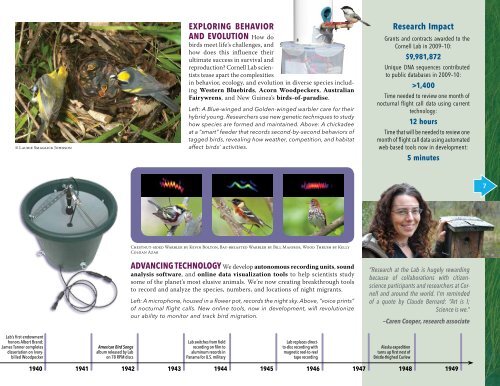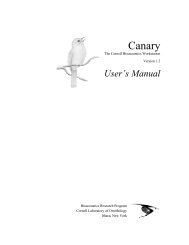LEADING CHANGE - Cornell Lab of Ornithology - Cornell University
LEADING CHANGE - Cornell Lab of Ornithology - Cornell University
LEADING CHANGE - Cornell Lab of Ornithology - Cornell University
Create successful ePaper yourself
Turn your PDF publications into a flip-book with our unique Google optimized e-Paper software.
© Laurie Smaglick Johnson<br />
exploring Behavior<br />
and Evolution How do<br />
birds meet life’s challenges, and<br />
how does this influence their<br />
ultimate success in survival and<br />
reproduction? <strong>Cornell</strong> <strong>Lab</strong> scientists<br />
tease apart the complexities<br />
in behavior, ecology, and evolution in diverse species including<br />
Western Bluebirds, Acorn Woodpeckers, Australian<br />
Fairywrens, and New Guinea’s birds-<strong>of</strong>-paradise.<br />
Left: A Blue-winged and Golden-winged warbler care for their<br />
hybrid young. Researchers use new genetic techniques to study<br />
how species are formed and maintained. Above: A chickadee<br />
at a “smart” feeder that records second-by-second behaviors <strong>of</strong><br />
tagged birds, revealing how weather, competition, and habitat<br />
affect birds’ activities.<br />
Research Impact<br />
Grants and contracts awarded to the<br />
<strong>Cornell</strong> <strong>Lab</strong> in 2009–10:<br />
$9,981,872<br />
Unique DNA sequences contributed<br />
to public databases in 2009–10:<br />
>1,400<br />
Time needed to review one month <strong>of</strong><br />
nocturnal flight call data using current<br />
technology:<br />
12 hours<br />
Time that will be needed to review one<br />
month <strong>of</strong> flight call data using automated<br />
web-based tools now in development:<br />
5 minutes<br />
7<br />
Chestnut-sided Warbler by Kevin Bolton, Bay-breasted Warbler by Bill Majoros, Wood Thrush by Kelly<br />
Colgan Azar<br />
Advancing Technology We develop autonomous recording units, sound<br />
analysis s<strong>of</strong>tware, and online data visualization tools to help scientists study<br />
some <strong>of</strong> the planet’s most elusive animals. We’re now creating breakthrough tools<br />
to record and analyze the species, numbers, and locations <strong>of</strong> night migrants.<br />
Left: A microphone, housed in a flower pot, records the night sky. Above, “voice prints”<br />
<strong>of</strong> nocturnal flight calls. New online tools, now in development, will revolutionize<br />
our ability to monitor and track bird migration.<br />
“Research at the <strong>Lab</strong> is hugely rewarding<br />
because <strong>of</strong> collaborations with citizenscience<br />
participants and researchers at <strong>Cornell</strong><br />
and around the world. I’m reminded<br />
<strong>of</strong> a quote by Claude Bernard: “Art is I;<br />
Science is we.”<br />
—Caren Cooper, research associate<br />
<strong>Lab</strong>’s first endowment<br />
honors Albert Brand;<br />
James Tanner completes<br />
dissertation on Ivorybilled<br />
Woodpecker<br />
American Bird Songs<br />
album released by <strong>Lab</strong><br />
on 78 RPM discs<br />
<strong>Lab</strong> switches from field<br />
recording on film to<br />
aluminum records in<br />
Panama for U.S. military<br />
<strong>Lab</strong> replaces directto-disc<br />
recording with<br />
magnetic reel-to-reel<br />
tape recording<br />
Alaska expedition<br />
turns up first nest <strong>of</strong><br />
Bristle-thighed Curlew<br />
1940 1941 1942 1943 1944 1945 1946 1947 1948 1949

















